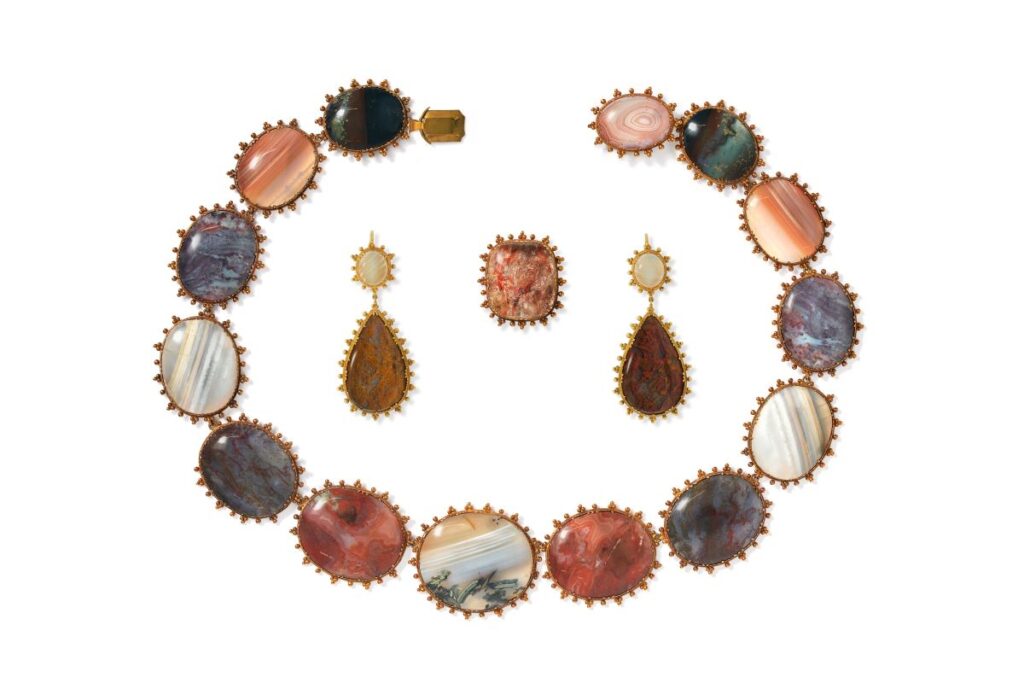
The abundance, strength, and exuberant beauty of agate have made the storied hardstone a favored material of makers back to ancient times. As long as there have been stonecutters creating objects and jewelry, agate has been at the heart of their production, found in neolithic beads, Roman seals, Renaissance tables, Regency necklaces, and modern jewelry. Common enough to be picked up from a riverbed on a hike, in the hands of a master lapidary and goldsmith agate can become extraordinary, like this nineteenth-century necklace featuring the translucent stone.
Centered on creamy agate with graffiti-like green inclusions, the necklace from Wartski, the London dealer, displays an array of painterly colors including rust, lavender, and deep green. The necklace is unsigned, probably English in origin, but the lack of marking shows that the important elements are the stones, paired symmetrically by color moving to the back of the neck. Thomas Holman of Wartski says, “the fascination with agates extends back into antiquity. There was a long history of people believing the gods had put images—extraordinary patterns, color, and shapes—in the stones, and it was the job of the lapidary to unveil these scenes.” The stone cutting was thoughtful, showing the hand of an expert lapidary who maximized the revelation of pattern to create drama and movement. A goldsmith then set the slices, Thomas says, “with an open back, so light can flood through them and illuminate the stone.”
Perhaps the Bridgerton character Mrs. Featherington, she of the over-the-top gowns, would embrace the bold orange and purple scheme. However, this agate necklace is steeped in history and travel. It is more likely the kind of gift Colin would bring back from Italy for Penelope, and it would spark conversation about naturalism, Roman ruins, and unconventional beauty. The wearer of this necklace would explore the materials and history at play.
Agate typically forms when water flows through ash, filling a void in volcanic rock. The pools sit for millennia, eventually solidifying into layered bands of silica. Inclusions may give accents that seem tree-like or suggest entire landscapes. Agate is the translucent, included form of chalcedony, and jasper is the opaque included form. The natural processes create the unusual patterns that Holman compares to “looking into the sky and seeing images in clouds—they are fascinating.”
Artisans have been drawn to the stone throughout history. The Greeks and Romans made clever use of the banded color to create relief cameos and seals. When used for flooring and furniture, agate is often combined with other semiprecious hardstones, including marble, turquoise, limestone, and lapis lazuli. In the nineteenth century, specimen tabletops were a cherished purchase for wealthy travelers to Italy, particularly those on the Grand Tour, eager to show their erudite connection to classical history. Inlaid tabletops could be as simple as a square grid or as ornate as an elaborate pietra dura foliate scene. A handwritten diagram of the stone types would reference the specimens and, sometimes, what ruin they had been pilfered from. The tabletops would be brought home, and a furniture maker commissioned to make legs that could be anything from elaborate caryatids to simple fluted supports.
A portrait of Roman noble Marchesa Margherita Boccapaduli by Laurent Pécheux (1777) shows her touching a display of pinned butterflies atop a specimen table with an Egyptian-style base, standing in a room filled with wonderful objects, a cabinet of curiosities intended to show her education and interests. Such tables are a direct reference to sixteenth-century examples, including the magnificent Farnese Table at the Metropolitan Museum of Art. Designed by Jacopo (also known as Giacomo) Barozzi da Vignola around 1565 for Cardinal Alessandro Farnese, a man of enormous wealth and an enthusiastic patron of the arts, the table, featuring a mix of semiprecious stones, was to be a centerpiece in his treasure-filled Roman palace. In turn, it is thought the table was inspired by the intact patterned marble floor of the Curia Julia (44 bc) at the Forum in Rome.
Like a souvenir tabletop, it is likely the agate slices in the nineteenth-century necklace were purchased on a trip and brought home to England for setting in gold. In Regency and Victorian London such finds were trea-sured. Queen Victoria had several hardstone jewels in simple gold mounts created from stones she collected at Woburn Abbey, Windsor, and other locations. The modest material makes a beautiful and meaningful presentation. An 1870 portrait of Enid Layard by Vicente Palmaroli y González depicts her wearing a necklace created from ancient hardstone seals given by her husband, historian and diplomat Henry Layard. In her diaries she describes donning the piece for a dinner with Queen Victoria and having it passed around and admired, a wearable topic of conversation.

